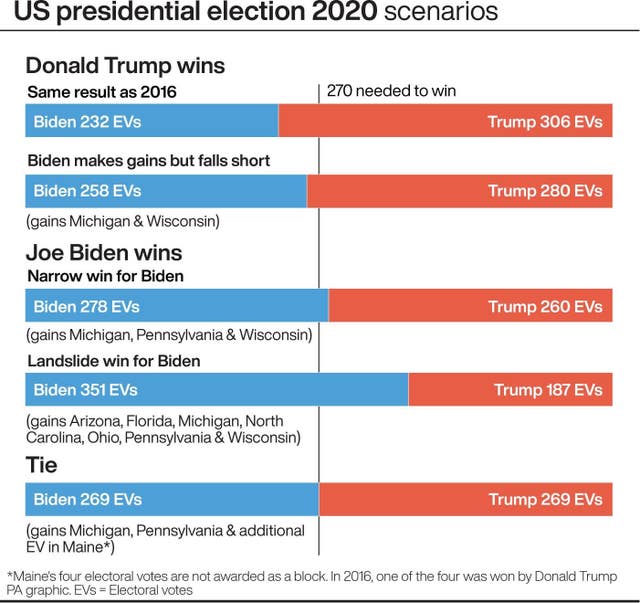
DEMOCRATIC candidate Joe Biden heads into the 2020 US presidential election as favourite to beat Republican President Donald Trump.
But while Biden has enjoyed a comfortable lead in nationwide opinion polls for several months, his lead in some of the key battleground states is much smaller.
Polls are snapshots, not predictions, and the outcome of the election could come down to how well the parties manage to get their supporters to turn out and vote.
Both sides will remember what happened in 2016, when opinion polls suggested Hillary Clinton was heading for victory – only for Trump to end up the winner.
Here are five scenarios for what could happen this year.
 (PA graphic)
(PA graphic)
1. A rerun of 2016
The polls are wrong again. Joe Biden fails to get enough support in states that Donald Trump won narrowly in 2016 – places like Pennsylvania and Michigan – while losing badly in longshots like North Carolina and Georgia. Were no states to change hands, the result would be a repeat of four years ago, with Joe Biden winning 232 electoral votes and Donald Trump 306.
(A total of 270 electoral votes are needed to win the US presidential election. Each state is allotted a fixed number of electoral votes, based roughly on the size of its population. Whoever wins the popular vote in a state also wins all of that state’s electoral votes – with two exceptions being Maine and Nebraska, which divide up their electoral votes partly based on who wins the popular vote.)
2. Biden falls short
In this scenario Joe Biden gains a couple of extra states, but doesn’t pick up quite enough electoral votes to make it to 270. For example, winning Michigan (worth 16 electoral votes) and Wisconsin (10) would increase Biden’s tally from 232 to 258: 12 short of the winning line. Donald Trump’s tally would fall from 306 to 280, but he’d still be safely above the 270 mark. Trump can therefore afford to lose one or two states to his opponent, but no more than that.
3. Narrow win for Biden
Gaining just three states – the former ‘blue wall’ of Michigan (16 votes), Pennsylvania (20) and Wisconsin (10) – would be enough to put Joe Biden above 270, taking his tally from 232 to 278. Alternatively Biden need only pick up Florida (29 votes) and Arizona (11) to also be over the 270 mark. Or he could go for a mix of northern and southern states, for example Pennsylvania and Florida. Biden has a number of paths to reach the magic number of 270, though a narrow victory could be more likely to invite legal challenges – justified or otherwise – from Trump.
4. A landslide for Biden
If the polls turn out to be not just snapshots but accurate predictions, and are even understating Joe Biden’s popularity, then Biden could be heading for seven or even eight gains from Donald Trump. An example of a landslide win would be if Biden picks up Arizona (11 votes), Florida (29), Michigan (16), North Carolina (15), Ohio (18), Pennsylvania (20) and Wisconsin (10): a total of 119 additional electoral votes, leaving him with a grand total of 351 compared with Trump’s 187. By way of a comparison, in 2008 Barack Obama won 365 votes to John McCain’s 173.
5. A tie
This is possible. Were Joe Biden to pick up Michigan (16 votes), Pennsylvania (20) and one of Maine’s four electoral votes, both he and Donald Trump would be tied on 269 electoral votes. Similarly, if Biden gained Michigan (16) plus Wisconsin (10) plus Arizona (11), both he and Trump would end up with 269 each. In this situation, the newly-elected House of Representatives would choose the president, with each state delegation having one vote. A majority of states (26) would be needed to win.


Comments: Our rules
We want our comments to be a lively and valuable part of our community - a place where readers can debate and engage with the most important local issues. The ability to comment on our stories is a privilege, not a right, however, and that privilege may be withdrawn if it is abused or misused.
Please report any comments that break our rules.
Read the rules hereLast Updated:
Report this comment Cancel